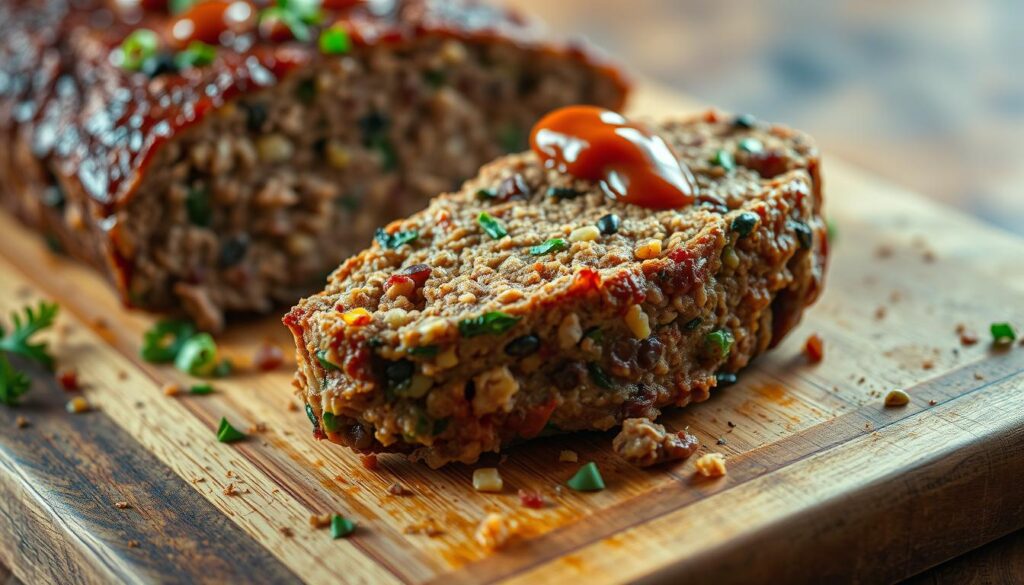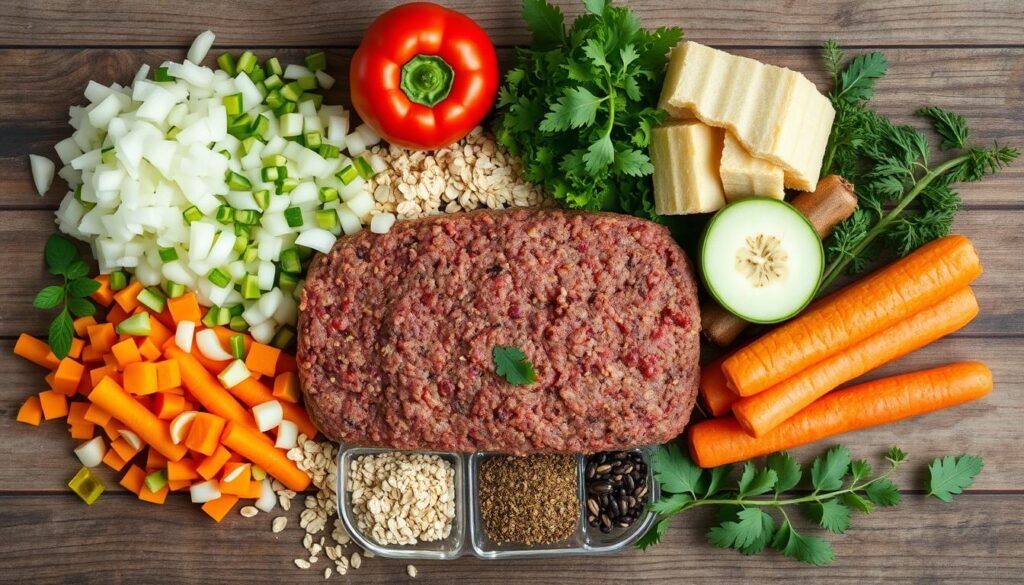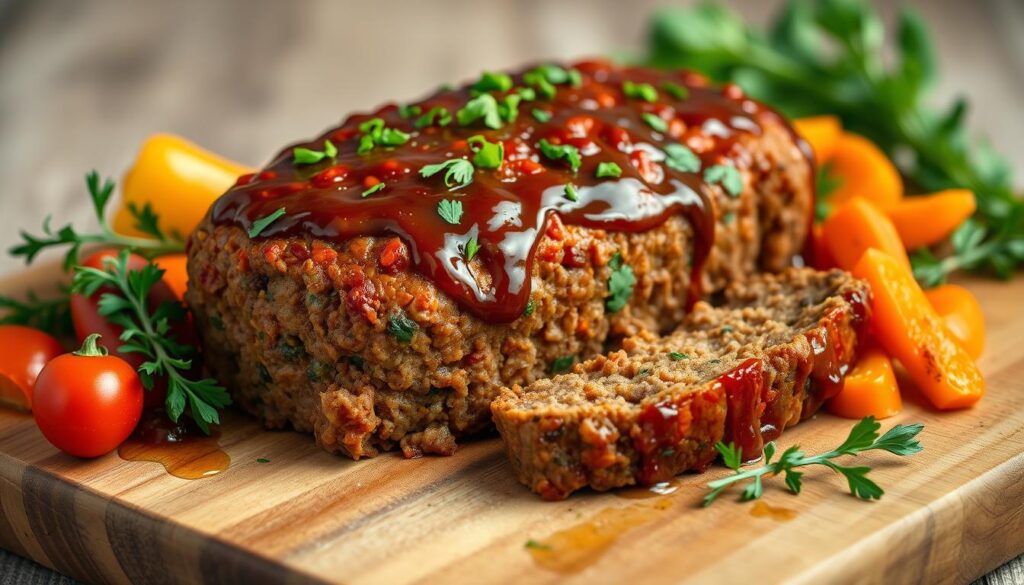As a busy parent, finding easy, tasty, and healthy dinner ideas is key. Homemade vegetarian meatloaf has become a favorite in our home. It’s full of flavor, has a great texture, and is good for us. It’s a win for everyone.
I’m excited to share my favorite vegetarian meatloaf recipe. It’s perfect for family dinners or special occasions. This non-meat meatloaf is great for vegetarians and anyone wanting to eat more plants.
Table of Contents
Why Choose Vegetarian Meatloaf for Your Next Dinner
More people are trying vegetarian meatloaf as plant-based diets grow in popularity. It’s good for health and the environment. This meat-free option is tasty and versatile.
Health Benefits of Plant-Based Alternatives
Vegetarian meatloaf is healthier than traditional meatloaf. It has less saturated fat and cholesterol. This makes it better for your heart.
It’s also full of fiber, vitamins, and minerals. These nutrients support your overall health and well-being.
Environmental Impact of Meat-Free Choices
Choosing vegan meatloaf recipes or vegetarian meatloaf recipe helps the planet. Meat production uses more land, water, and energy than plants. So, a vegetarian meatloaf recipe is better for the environment.
Cost-Effectiveness of Vegetarian Options
Vegan meatloaf recipes and vegetarian meatloaf recipe ingredients are cheaper. Beans, lentils, and tofu are less expensive than meat. This makes vegetarian meatloaf recipe options great for saving money without losing flavor or nutrition.
Vegetarian meatloaf offers health, environmental, and financial benefits. It’s a smart choice for dinner. Try it and find a new favorite dish for your family.
Essential Ingredients for Perfect Non-Meat Meatloaf
Making a tasty vegetarian meat loaf recipe or a delicious plant based meatloaf begins with picking the right ingredients. These alternatives to traditional meatloaf can be just as tasty and satisfying. They offer a great mix of textures and flavors.
At the core of a great vegetarian meat loaf recipe are often lentils, mushrooms, or a mix of both. Lentils offer a hearty, protein-rich base that feels like ground meat. Mushrooms add an earthy, umami-rich taste to the dish.
- Lentils: Choose brown, green, or red lentils for their different flavors and textures.
- Mushrooms: Cremini, portobello, or shiitake mushrooms are great for a meaty texture.
Nuts and seeds are key in binding the plant based meatloaf together and adding to its texture. Walnuts, pecans, and sunflower seeds are top choices.
- Nuts: Walnuts, pecans, and almonds add crunch and richness.
- Seeds: Sunflower, flax, and chia seeds help bind the ingredients together.
Vegetables like onions, carrots, celery, and bell peppers add flavor and help make the vegetarian meat loaf recipe moist and cohesive. Remember to include a binder, such as breadcrumbs or oats, to keep everything together.
“The key to a successful plant based meatloaf lies in finding the right balance of ingredients that mimic the texture and flavor of traditional meatloaf, while still remaining true to plant-based principles.”
Kitchen Tools and Equipment You’ll Need
Making a tasty vegetarian meatloaf needs more than just good ingredients. The right tools and equipment are key to getting the perfect texture and taste. As a home cook, I’ve found the must-have utensils, gadgets, and baking dishes for a great non-meat meatloaf.
Must-Have Utensils
- A sturdy mixing bowl for combining the ingredients
- A sharp chef’s knife for dicing vegetables
- A grater or food processor to shred and chop ingredients
- A spatula or wooden spoon for mixing and shaping the meatloaf
- A baking sheet or loaf pan for baking the vegetarian meatloaf
Optional Kitchen Gadgets
While basic utensils are a must, some optional gadgets can make non meat meatloaf prep easier:
- A food processor or high-powered blender for a smooth texture
- A stand mixer with a paddle attachment for easy mixing
- A meat thermometer to check if the meatloaf is cooked right
Baking Dish Recommendations
The baking dish you pick can affect your vegetarian meatloaf‘s look. Here are some suggestions:
- A traditional loaf pan for a classic shape
- An oven-safe casserole dish for a rustic look
- A baking sheet lined with parchment paper for a free-form style
With the right tools and equipment, you’re ready to make a delicious, mouthwatering non meat meatloaf that everyone will enjoy.
Preparing Your Vegetarian Meatloaf Base
Starting with a solid vegan meatloaf recipes or vegetarian meatloaf recipe base is key. This base holds everything together, making sure your meatloaf is both cohesive and tasty. Let’s look at how to make this important part of your plant-based meatloaf.
First, cook any grains or legumes you plan to use. Quinoa, brown rice, or lentils are great choices. They add structure and nutrition. Just follow the package instructions to cook them, then let them cool a bit.
Then, sauté some aromatic veggies like onions, garlic, and bell peppers. These add a rich flavor to your base. Make sure to chop them finely or blend them for a smooth texture.
- When your grains/legumes and veggies are ready, mix them in a big bowl.
- Use a potato masher or fork to mash the mix gently. This keeps some texture and avoids a smooth paste.
- This base is the heart of your vegan meatloaf recipes or vegetarian meatloaf recipe. It’s hearty and full of flavor.
“The key to a great vegetarian meatloaf is a well-developed base that holds everything together and adds depth of flavor.”
Now, you’re ready to make a tasty plant-based meatloaf. Next, we’ll talk about the secret ingredients that will elevate your meatloaf even more!
Secret Binding Ingredients That Work
Creating the perfect vegetarian meat loaf recipe or plant-based meatloaf is all about the right texture. The secret lies in the binding ingredients. These special additions keep the loaf together, making it a satisfying meatless dish. Let’s look at some top binding agents for your homemade vegetarian meatloaf.
Plant-Based Egg Substitutes
Eggs are key in traditional meatloaf, but we need plant-based options for vegetarian or vegan versions. Here are some great substitutes:
- Flaxseeds or chia seeds – Mix them with water to get a gel-like texture, just like eggs.
- Aquafaba (chickpea liquid) – Whip it into a frothy, egg-like consistency.
- Silken tofu – Blend it to add moisture and help bind the ingredients.
Natural Thickening Agents
There are also natural thickeners that can enhance your vegetarian meatloaf’s texture. Try adding:
- Bread crumbs or rolled oats – They soak up moisture and add structure.
- Ground nuts or seeds – Almond meal, ground flaxseeds, or nut butters help bind.
- Grated vegetables – Carrots, zucchini, or potatoes add moisture and help hold the loaf.
Trying different plant-based egg substitutes and natural thickeners is key. It helps you make the perfect vegetarian meatloaf. With these secrets, you can create a meatless dish that everyone will love.
Mastering the Perfect Texture
Getting the right texture in a vegetarian meatloaf is key for a great meal. It’s all about finding the right mix of moisture, ingredients, and cooking methods. Let’s explore how to make a non-meat meatloaf that’s so good, everyone will want more.
Keeping the right amount of moisture is a big challenge. Too much makes it soggy, too little makes it dry. The trick is to pick the right ingredients and mix them just right. Try using different binders like breadcrumbs, oats, or ground nuts to get the perfect texture.
The mix of wet and dry ingredients also matters a lot. Finding the right balance helps your vegetarian meatloaf stay juicy and firm. Watch how much moisture your veggies, grains, and proteins have, and adjust them to get the texture you want.
| Ingredient | Ideal Ratio for Moist Texture |
|---|---|
| Breadcrumbs | 1/2 cup per 1 pound of protein |
| Oats | 1/4 cup per 1 pound of protein |
| Ground Nuts | 1/3 cup per 1 pound of protein |
The way you cook your non-meat meatloaf also affects its texture. Baking it slowly at a moderate temperature helps it set well. This way, the flavors blend and the texture becomes rich and smooth. Avoid cooking it too fast, as it can dry out the outside before the inside is cooked.
By balancing moisture, ingredients, and cooking methods, you can make a vegetarian meatloaf that’s both tasty and satisfying. Try different things and adjust as needed until it’s just right for you.

Seasoning and Spice Combinations
Creating the perfect vegetarian meatloaf recipe is all about the right seasoning and spice mix. You can try Mediterranean, classic American, or Asian-inspired flavors. Let’s dive into how you can make your vegan meatloaf stand out.
Mediterranean Blend Options
For a Mediterranean twist, mix herbs like oregano, basil, and rosemary. Add warm spices like cumin, paprika, and cinnamon. Sun-dried tomatoes, kalamata olives, and feta can add a Mediterranean touch.
Classic American Flavors
For a traditional American taste, use garlic powder, onion powder, and smoked paprika. A bit of Worcestershire sauce or its plant-based version adds depth. Top it with ketchup or barbecue sauce for a tasty glaze.
Asian-Inspired Variations
For a global flavor, try Asian-inspired vegan meatloaf. Use ginger, garlic, and soy sauce or tamari. Add toasted sesame seeds, Chinese five-spice, and rice vinegar or mirin for a unique taste.
Vegetarian meatloaf recipes are all about trying new flavors. Experiment with different spice mixes to find what you love.
Step-by-Step Mixing Process
Making a great vegetarian meatloaf begins with mixing well. Follow these easy steps to make your plant-based meatloaf recipe come to life:
- Start by collecting your dry ingredients like breadcrumbs, oats, or ground nuts in a big bowl.
- Then, add the wet stuff: your vegetarian meat choice, flax or chia eggs, and maybe some nut butter or aquafaba.
- Mix everything gently. You want it to stick together but not too much. It should be a bit sticky and hold its shape.
- If it’s too dry, add some vegetable broth or plant-based milk. If it’s too wet, add more breadcrumbs or oats.
Getting the mix just right is key for a great plant based meatloaf. With a bit of practice, you’ll get it down in no time!

| Ingredient | Amount |
|---|---|
| Breadcrumbs | 1 cup |
| Oats | 1/2 cup |
| Flax eggs (1 tbsp ground flax + 3 tbsp water) | 2 eggs worth |
| Vegetable broth | 1/4 cup |
| Nut butter | 2 tbsp |
“The key to a perfect vegetarian meat loaf recipe is in the mixing. Take your time and pay attention to the consistency – it should be just right to hold its shape and bake up beautifully.”
Baking Temperature and Timing Guide
Getting the perfect vegetarian meatloaf needs careful attention to baking temperature and timing. Whether you’re making a traditional non-meat meatloaf or trying plant-based alternatives, mastering these elements is key. It ensures your dish is moist, flavorful, and satisfying every time.
Ideal Temperature Settings
For the best results, preheat your oven to 375°F (190°C). This temperature is perfect, allowing the outside to brown while the inside cooks well. Avoid higher temperatures, as they can overcook the edges or undercook the center.
Testing for Doneness
To check if your vegetarian meatloaf is ready, use a meat thermometer. It should reach an internal temperature of 165°F (75°C). You can also visually check – the top should be lightly browned, and the edges should be pulling away from the dish.
| Baking Temperature | Baking Time | Internal Temperature |
|---|---|---|
| 375°F (190°C) | 55-60 minutes | 165°F (75°C) |
By following these guidelines, you’ll create a perfect vegetarian meatloaf. Your family and friends will love it.
Delicious Glazing Options
Adding a tasty glaze to your homemade vegetarian meatloaf can really boost its flavor and look. You can choose from many savory or sweet glazes to make your vegan or vegetarian meatloaf stand out.
Savory Glazing Recipes
Try a tangy BBQ glaze for a savory twist. Mix ketchup, Dijon mustard, and a bit of brown sugar or molasses. Brush it over your meatloaf for the last 15 minutes of baking.
For a rich, Italian taste, use a tomato-based glaze. Mix tomato paste, garlic, basil, and red wine vinegar. Spread it on before baking.
Sweet Glaze Options
- Maple Mustard Glaze: Whisk together maple syrup, Dijon mustard, and a touch of soy sauce for a sweet-and-savory combination.
- Apricot Glaze: Blend apricot preserves or jam with a bit of vinegar and spices like cumin or chili powder for a fruity and tangy finish.
- Pineapple Glaze: Mix pineapple preserves or crushed pineapple with a hint of soy sauce and brown sugar for a tropical flair.
Choose any glaze you like and apply it for the last 15-20 minutes of baking. This will make your vegetarian meatloaf look and taste amazing, impressing everyone at dinner.

Serving Suggestions and Side Dishes
There are many ways to serve your tasty vegetarian meatloaf. Pair it with side dishes that complement its flavors. Choose from a variety of vegetables and sauces to make your meal complete.
Compatible Vegetables
- Roasted Brussels sprouts or cauliflower
- Steamed broccoli or green beans
- Mashed sweet potatoes or butternut squash
- Sautéed spinach or kale
- Grilled asparagus or zucchini
Sauce Pairings
For extra flavor, try these sauces with your vegetarian meatloaf:
- Tangy barbecue sauce
- Creamy mushroom gravy
- Flavorful marinara or tomato-based sauce
- Zesty chimichurri or pesto
- Rich and savory mushroom or onion gravy
Pair your plant based meatloaf with veggies and sauces for a full meal. It will taste great and be good for you too.
Storage and Reheating Tips
Enjoying your homemade vegetarian meatloaf is easy. Just follow these simple tips for storing and reheating. This way, you can keep the flavor and texture of your non meat meatloaf just right.
Refrigerating Leftover Vegetarian Meatloaf
Put leftover vegetarian meatloaf in an airtight container in the fridge. It stays good for 3-4 days, perfect for meal prep. Let it cool down before putting it in the fridge.
Freezing Vegetarian Meatloaf for Later
- Slice the meatloaf into portions before freezing for easy reheating.
- Wrap each slice in plastic wrap or foil to avoid freezer burn.
- Put the wrapped slices in a freezer-safe bag or container. Frozen vegetarian meatloaf stays good for up to 3 months.
Reheating Leftover Vegetarian Meatloaf
- Preheat your oven to 350°F (175°C).
- For chilled leftovers, put slices or the whole loaf in a dish. Cover with foil to keep it moist.
- If frozen, thaw it in the fridge overnight before reheating.
- Bake for 15-20 minutes, until it’s hot through.
- Brush with barbecue sauce or ketchup for extra flavor and moisture.
By following these tips, you can enjoy your vegetarian meatloaf anytime. You won’t lose its delicious taste and texture.
Common Mistakes to Avoid
Making the perfect vegetarian meatloaf is a fun journey. But, there are a few common mistakes to watch out for. Knowing these can help your vegan and vegetarian meatloaf recipes come out great every time.
Texture Problems
Getting the right texture in meatless meatloaf is a big challenge. If it’s too wet, the loaf will be dense and heavy. If it’s too dry, it will be crumbly and hard to slice. The trick is to find the right mix of binding ingredients and moisture.
- Overmixing can make the loaf gummy and dense. Mix gently to keep the texture right.
- Not enough binding agents, like breadcrumbs or ground flax, can cause it to fall apart.
- Overcooking can dry out the meatloaf, losing its moist, firm texture.
Seasoning Issues
Seasoning is key for a tasty vegetarian meatloaf. Without meat’s umami, you need a good mix of spices and herbs.
- Not enough seasoning can make the dish taste bland.
- Too much garlic or onion can overpower the other flavors.
- Not tasting and adjusting the seasoning during cooking can lead to uneven flavors.
By avoiding these common mistakes, you’ll get better at making delicious vegan and vegetarian meatloaf recipes. With practice and attention to detail, you’ll soon be a pro at making meatless meatloaf.
Conclusion
The vegetarian meat loaf recipe is a great choice for dinner. It’s tasty, healthy, and good for the planet. By choosing plant-based meatloaf, you get the best of both worlds.
This guide should help you make a tasty vegetarian meatloaf. The secret is to get the texture right and use the right seasonings. Also, finding the right ingredients to bind everything is key. Soon, you’ll be making amazing meatloaves.
So, let’s start cooking! Get your ingredients ready and preheat the oven. I’m excited for you to try this recipe. It’s sure to become a favorite in your home. Bon appétit!



